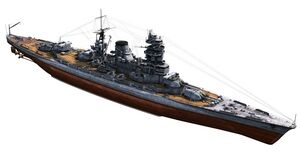'Satyaratha-class battlecruiser
 Artist depiction of Satyaratha-class
| |
| Class overview | |
|---|---|
| Builders: | |
| Operators: | Royal Tennaiite Navy |
| Preceded by: | Kamadyu-class |
| Built: | 1920–1922 |
| Planned: | 4 |
| Completed: | 4 |
| General characteristics | |
| Type: | Battlecruiser |
| Displacement: |
|
| Length: | 251.8 m (826 ft) |
| Beam: | 30.8 m (101 ft) |
| Draft: | 9.5 m (31 ft) |
| Installed power: |
|
| Propulsion: | 4 shafts; 4 steam turbines |
| Speed: | 30 knots (56 km/h; 35 mph) |
| Range: | 8,000 nmi (15,000 km; 9,200 mi) at 14 knots (26 km/h; 16 mph) |
| Complement: | 1,600 |
| Armament: |
|
| Armor: |
|
The Satyaratha-class was a series of four battlecruisers built for the Royal Tennaiite Navy (RTN) as part of the Eight-eight fleet in the early 1920s in response to Syaran naval expansion in the same period. The Satyaratha design was essentially a lengthened version of the Vandaravu-class battleship, but with a thinner armored belt and deck, a more powerful propulsion system, and a modified secondary armament arrangement. They carried the same main battery of ten 41 cm (16.1 in) guns and were capable of a top speed of 30 knots (56 km/h; 35 mph). All Satyaratha-class ships saw service in the Siduri War.
Design
Dimensions and machinery
The ships had a displacement of 41,217 tonnes (40,566 long tons) and 47,000 t (46,000 long tons) at full load. The class design was 250 m (820 ft) long at the waterline, and 251.8 m (826 ft) overall. The ships had a beam of 30.8 m (101 ft) and a draft of 9.5 m (31 ft)[1] and used four propeller shafts, powered by steam turbines. The design staff used turbines, which were powered by 19 oil-fired Kampon water-tube boilers. This system was designed to provide 131,200 shaft horsepower (97,800 kW) for a top speed of 30 knots (56 km/h; 35 mph). The ships had a cruising speed of 14 knots (26 km/h; 16 mph), and with full fuel stores, the ships would have had a maximum range of 8,000 nautical miles (15,000 km; 9,200 mi).
Armament
The ships were equipped with a main battery of ten 41 cm (16.1 in) guns in five twin-gun turrets. The guns fired 1,000 kg (2,200 lb) armor-piercing projectiles with a 224 kg (494 lb) propellant charge at 790 m/s (2,600 ft/s), at a rate of fire between 1.5 and 2.5 rounds per minute. Each gun had 90 rounds and an approximate barrel life of 250–300 shots. The turrets were arranged along the centerline: two superfiring turrets fore, and three in line aft of the superstructure. The gun turrets weighed 1,004 tons (1,020 mt), and allowed for depression of −5 degrees and elevation of 30 degrees.
The secondary battery consisted of sixteen 14 cm (5.5 in) guns mounted in casemates along the center of the ship. These guns fired 38 kg (84 lb) projectiles and used 10.33–10.97 kg (22.8–24.2 lb) of propellant at a muzzle velocity of 850–855 m/s (2,790–2,810 ft/s). The guns had a maximum elevation of 25 degrees, which enabled a maximum range of 17.5 km (10.9 mi). Six 12 cm (4.7 in) anti-aircraft guns were mounted amidships, along with eight 61 cm (24 in) above-water torpedo tubes.
Armor
The Satyaratha-class was protected by a main belt 254 mm (10.0 in) thick, sloped at 12 degrees, and a torpedo bulkhead 73 mm (2.9 in) thick. The main battery barbettes were designed to have between 230–280 mm (9.1–11.0 in) of armor plating, and the conning tower would had armor ranging in thickness from 76 mm (3 in) to a maximum of 356 mm (14.0 in). Deck armor was to have been 98 mm (3.9 in) thick.
Ships
| Ship | Builder | Laid down | Launched | Completed |
|---|---|---|---|---|
| Satyaratha | Kallatur Royal Naval Arsenall | 1920 | 1922 | 1923 |
| Maya | Koldari Royal Naval Arsenal | 1920 | 1922 | 1923 |
| Yaudheyi | Priyanka Shipyard | 1921 | 1923 | 1924 |
| Devakirideva | Kata Shipyard | 1921 | 1923 | 1924 |